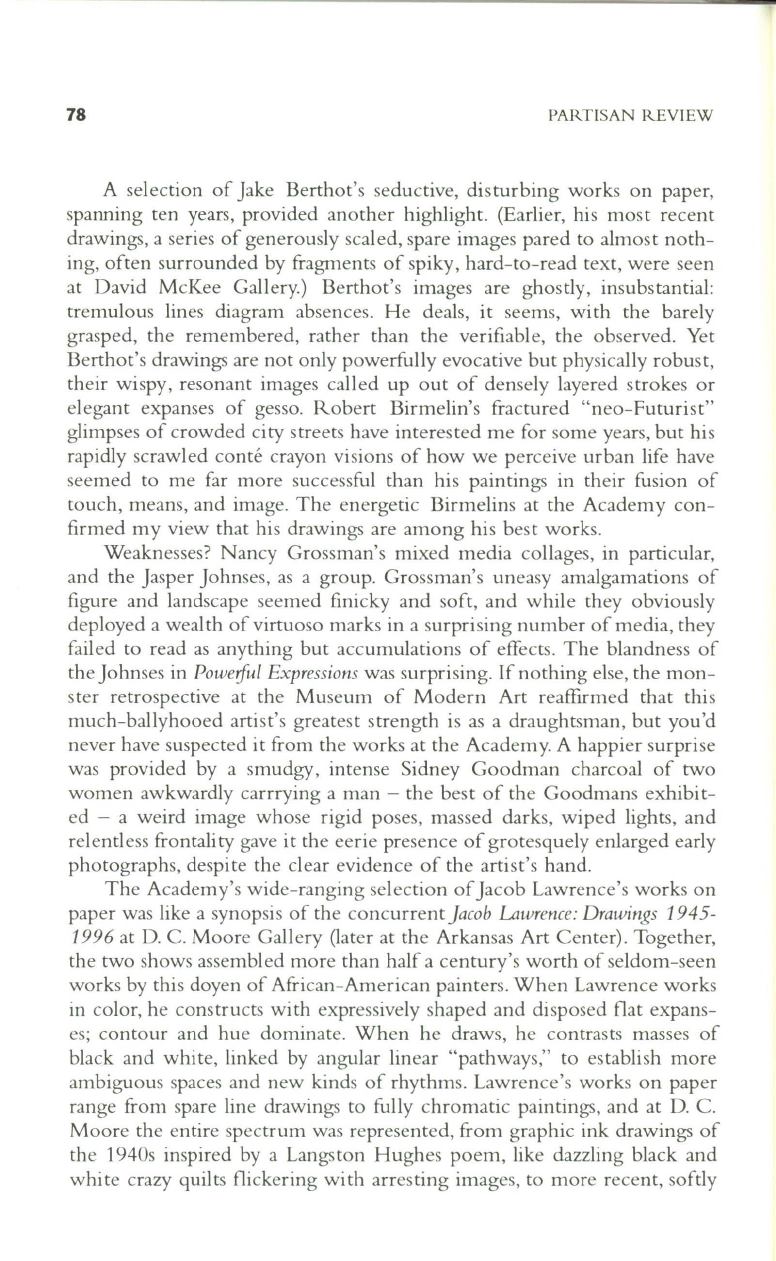
78
PARTISAN IliVIEW
A selection of Jake Berthot's seductive, disturbing works on paper,
spanning ten years, provided another highlight. (Earlier, his most recent
drawings, a series of generously scaled, spare images pared to almost noth–
ing, often surrounded by fragments of spiky, hard-to-read text, were seen
at David McKee Gallery.) Berthot's images are ghostly, insubstantial:
tremulous lines diagram absences. He deals, it seems, with the barely
grasped, the remembered, rather than the verifiable, the observed. Yet
Berthot's drawings are not only powerfully evocative but physically robust,
their wispy, resonant images called up out of densely layered strokes or
elegant expanses of gesso. Robert Birmelin's fractured "neo-Futurist"
glimpses of crowded city streets have interested me for some years, but his
rapidly scrawled conte crayon visions of how we perceive urban life have
seemed to me far more successful than his paintings in their fusion of
touch, means, and image. The energetic Birmelins at the Academy con–
firmed my view that his drawings are among his best works.
Weaknesses? Nancy Grossman's mixed media collages, in particular,
and the Jasper Johnses, as a group. Grossman's uneasy amalgamations of
figure and landscape seemed finicky and soft, and while they obviously
deployed a wealth of virtuoso marks in a surprising number of media, they
failed to read as anything but accumulations of effects. The blandness of
the Johnses in
Poweiful Expressions
was surprising.
If
nothing else, the mon–
ster retrospective at the Museum of Modern Art reaffirmed that this
much-ballyhooed artist's greatest strength is as a draughtsman, but you'd
never have suspected it from the works at the Academy. A happier surprise
was provided by a smudgy, intense Sidney Goodman charcoal of two
women awkwardly carrrying a man - the best of the Goodmans exhibit–
ed - a weird image whose rigid poses, massed darks, wiped lights, and
relentless frontality gave it the eerie presence of grotesquely enlarged early
photographs, despite the clear evidence of the artist's hand.
The Academy's wide-ranging selection ofJacob Lawrence's works on
paper was like a synopsis of the concurrent
Jacob Lawrence: Drawings 1945-
1996 at
D.
C.
Moore Gallery Oater at the Arkansas Art Center). Together,
the two shows assembled more than half a century's worth of seldom-seen
works by this doyen of African-American painters. When Lawrence works
in color, he constructs with expressively shaped and disposed flat expans–
es; contour and hue dominate. When he draws, he contrasts masses of
black and white, linked by angular linear "pathways," to establish more
ambiguous spaces and new kinds of rhythms. Lawrence's works on paper
range from spare line drawings to fully chromatic paintings, and at
D.
C.
Moore the entire spectrum was represented, from graphic ink drawings of
the 1940s inspired by a Langston Hughes poem, like dazzling black and
white crazy quilts flickering with arresting images, to more recent, softly


